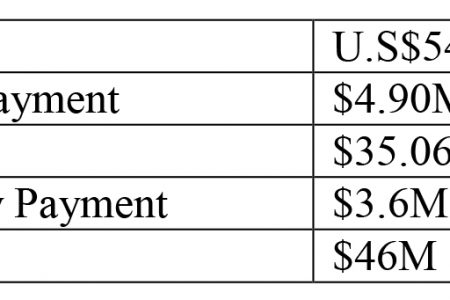
Payara is main oil focus now – Ali
Government’s immediate focus in the oil and gas sector is on the review of ExxonMobil’s Payara project, local content, and a natural gas to shore project, President Irfaan Ali said yesterday.
All the latest news and commentary on the new Guyana Oil and Gas sector include exploration, drilling, policy, impact and more.

Government’s immediate focus in the oil and gas sector is on the review of ExxonMobil’s Payara project, local content, and a natural gas to shore project, President Irfaan Ali said yesterday.

With Guyana being described as the “sunshine of oil countries” by one investor, a number of oil and gas projects are forging ahead here despite the contraction of the global economy due to the fallout from the COVID-19 pandemic, and Minister of Natural Resources Vickram Bharrat sees this as indicative of confidence in this country, its governance and economy.
The technical and legal teams from the Department of Energy remain in talks with ExxonMobil on the proposed agreement for the Payara Field Development Plan, Minister of Natural Resources Vickram Bharrat told Stabroek News last night.

Introduction Last week’s column continued my examination of the likely impact of the 2020 global general crisis on crude oil prices in world markets this year; and, following that, on the price obtained for Guyana’s Liza crude, as reflected in the price received for Government of Guyana, GoG, petroleum lifts, earned through its Production Sharing Agreement, PSA, with ExxonMobil and its partners.

With an average payment of about US$46 per barrel of oil, Guyana this week received US$46M for its third 1M barrels of oil entitlement and this reflects an increase of more than US$10 dollars per barrel than it received on its last lift.

Underscoring the importance of contract sanctity to investors, ExxonMobil yesterday hinted that it was willing to discuss with government the local content areas it can give more to but drew the line at any renegotiation of the controversial 2016 Production Sharing Agreement (PSA).

The first group of Guya-nese operations and maintenance trainees recently returned home after an extensive 18-month training programme in Canada organised by ExxonMobil Guyana.

The PPP/C government has scrapped the shortlist of 19 companies that had submitted proposals to sell Guyana’s portion of oil from the Liza-1 well and yesterday launched a new Request For Proposals (RFP).

ExxonMobil’s refusal to pay two fines to the Environmental Protection Agency (EPA) will see the oil major for the first time being taken to court by the agency which yesterday sounded a warning that it will not be intimidated.

On the heels of President Irfaan Ali’s announcement on Tuesday that the Payara project approval will have to wait on an international oil expert’s assessment and advice, ExxonMobil last night said that delays will reduce the value of the project and that more than a year had already been spent on the process.

The United Kingdom (UK) still has heightened investment interests in Guyana’s oil & gas sector says outgoing High Commissioner to Guyana Greg Quinn who hopes that this country maximises the support given to the sector from UK’s oil & gas capital, Aberdeen, in Scotland.

Bilateral co-operation between Georgetown and Paramaribo was over the weekend agreed when two recently-elected presidents – Guyana’s Irfaan Ali and Suriname’s Chandrika-persad Santokhi – held discussions on oil and gas and a bridge across the Corentyne among other areas.

Guyana’s oil reserves and investment potential were yesterday boosted by the Hess Corporation announcement that appraisal of the Yellowtail well and 13th discovery in the offshore Stabroek Block it shares with ExxonMobil and China National Offshore Oil Corporation (CNOOC) has yielded two additional reservoirs.

Even as the EPA works on “tightening the language” for permits so that start-up periods are not abused by companies, ExxonMobil is currently producing 98,000 barrels of oil per day at the Liza-1 offshore well and hopes to meet its 120,000 per day target on August 10th 2020, the same day that routine flaring is projected to end, Environmental Protection Agency (EPA) Director Dr Vincent Adams said yesterday.

LONDON, (Reuters) – A group of the world’s top oil companies including Saudi Aramco, China’s CNPC and Exxon Mobil have for the first time set targets to cut their combined greenhouse gas emissions as a proportion of production, as pressure on the sector’s climate stance grows.

ExxonMobil and two of its subcontractors were fined three times this year for minor spills of hydraulic fluid in the offshore Stabroek Block and the Environmental Protection Agency (EPA) says it wanted to underscore zero tolerance for lax maintenance and procedures in light of the large risk that such operations can pose to the environment and safety.

With an energy researcher warning of the potential environmental harm that could result from natural gas at Exxon’s Liza-1 project in the Stabroek Block, offshore Guyana, the company has assured that it has already implemented a leak detection and repair programme that utilises the latest technology.

ExxonMobil should prove it is using efficient gas flaring technology in oil operations offshore and it is also imperative that both Guyana and the company have stringent measures in place to monitor for leaks from its equipment as such emissions have stronger greenhouse effects, physicist and energy researcher Dr Robert Kleinberg says.
The Environmental Protection Agency (EPA) is being urged to implement a carbon tax on the crude oil currently being extracted in the offshore Stabroek Block by ExxonMobil’s subsidiary Esso Exploration and Production Guyana Ltd (EEPGL) which could earn Guyana billions annually.

-flaring equal to destroying 6.2 hectares of forest per day continuing Exxon’s flaring of over nine billion cubic feet of natural gas since oil production began in December is equivalent to the loss of 4,642 hectares of forest, which would be valued at US$24 million based on the carbon price under Guyana’s forest protection pact with Norway, says conservationist Dr David Singh.
The ePaper edition, on the Web & in stores for Android, iPhone & iPad.
Included free with your web subscription. Learn more.